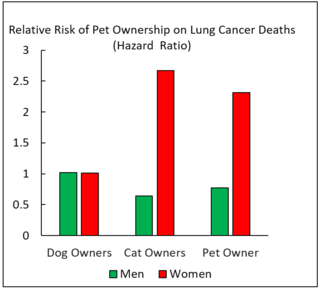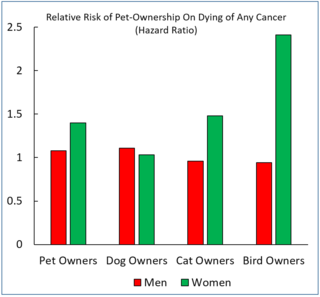Animal Behavior
The Strange Link Between Pet Ownership and Cancer In Women
Why should owning cats and birds be linked to cancer in women but not in men?
Posted August 26, 2019 Reviewed by Lybi Ma

The marketing departments of the $70-billion-a-year pet products industry are working overtime these days to convince you that pet ownership is the key to human health and happiness. (See, for example, The Pet Effect campaign developed by the industry-funded Human-Animal Bond Research Institute). In reality, however, the scientific evidence that pets are good for people is decidedly mixed. Some studies have indeed found pet owners are better off. But the corporate PR departments and the media conveniently ignore studies that report pet-owners are more susceptible to a host of maladies. These include hypertension, anxiety, depression, insomnia, gastric ulcers, migraine headaches, and obesity. And I suspect the pet food industry is not going to send out press releases on three recent studies that link pet ownership to cancer death rates.
The studies were conducted by a research group headed by Dr. Jian Zhang, an epidemiologist in the College of Public Health at Georgia Southern University. The three papers were based on data collected as part of the Center for Disease Control's National Health and Nutrition Examination Survey. Referred to as “NHANES,” this is a longitudinal study of the health and well-being of Americans that has been going on since the 1950s. The cancer research was based on data gathered during Phase III of the study which began in 1988. Baseline medical and socio-demographic information was collected during in-home interviews with 13,725 individuals who were representative of the American population. There were equal numbers of men and women: 75% of the subjects were White, 11% were Black and 5% were Latino.
About half of the Phase III participants were pet owners. As other studies have found, NHANES pet owners tended to be younger, wealthier, and more physically active than non-pet owners. And a higher proportion of them was White. (See Large Study Finds Pet Owners Are Different.) Yet some of the differences between NHANES pet owners and non-owners were unexpected. The pet owners were more likely to be heavy smokers than non-pet owners, and more of them had been diagnosed with asthma. And while pet owners were more physically active than non-owners, this did not translate into better health. Indeed, the pet owners were just as likely to be overweight as people who did not live with pets.
The focus of Dr. Zhane’s group was on cancer deaths. The researchers compared the numbers of pet owners and non-owners who died of cancer between 1988 and 2010. Most of their analyses were based on a statistic called a hazard ratio. Hazard ratios (or HRs) are the relative odds that bad things are associated with a condition, a treatment or an event. Take, for example, a hypothetical study of sex differences in contracting a rare tropical disease. If we were to find that over 10 years, the men in the imaginary study group were twice as likely to get the disease as women, the hazard ratio for being a man would be 2.0. If there were no sex differences, the hazard ratio would be 1.0 And in the event that the men were half as likely to suffer from the illness, the HR would be .50
Study 1. The Connection Between Pets and Colorectal Cancers
The first study was published in the Journal of Public Health. Between 1988 and 2010, 70 participants died of colorectal cancer. After adjusting for socioeconomic and demographic factors (“covariates”) such as age, smoking and drinking, exercise, race, and income, the researchers found pet owners were almost three times as likely as non-pet owners to have died of colorectal cancer (hazard ratio = 2.83). Surprisingly, this dramatic difference in colorectal cancer deaths was mostly attributable to living with a cat (hazard ratio = 2.67). Indeed, owning a dog did not increase their owners’ chances of getting cancer at all (hazard ratio = .90). In this study, there were no sex differences in the impact of pet ownership on colorectal cancer deaths. The researchers concluded, “From a nationally representative cohort, we found owning a pet, specifically a cat, was associated with an elevated hazard of dying from colorectal cancer.”
Study 2. The Pets and Lung Cancer Connection

Everyone knows that smokers are more likely to die of lung cancer than non-smokers. But are pet owners also more susceptible to this particularly lethal form of cancer? The second study by Dr. Zhang’s team was essentially identical to the first one, and it was also based on HNANES Phase III subjects. But in this case, the researchers examined the relationship between pet ownership and lung cancer deaths. Between 1988 and 2010, 213 of the participants died from lung cancer. Unlike the results of the colorectal cancer study, with lung cancer there was a sex difference. After adjusting for the covariates, pet-keeping had no impact on male lung cancer deaths.
With women, it was a different story. Pet-owning women were more than twice as likely to die of lung cancer as women who did not live with pets (hazard ratio = 2.67). Like the colorectal cancer study, there was no relationship between owning a dog and lung cancer for either sex. This was not true of cat owners. Men with cats were nearly 40% less likely to die of lung cancer than non-cat-owning men. Female cat owners, in contrast, were nearly three times as likely to have died of lung cancer as women without cats.
Study 3: Pets and the Risk of Dying of All Cancers

Among the NNANES III participants, 418 men and 303 women died of some form of cancer. The third study found, that after adjusting for the covariates (age, race, etc.), the chances of having succumbed to any form of cancer was about the same for male pet-owners and non-owners. Pet-owning women, however, were 40% more likely to have died from cancer (hazard ratio = 1.40). And the effect was largest was among women who owned birds (hazard ratio = 2.41) and cats (hazard ratio = 1.48). The good news was that living with a dog did not seem to have any relationship with cancer deaths in either sex.
Here’s a summary of the results of the three studies.
- Women who owned cats or birds had considerably higher rates of lung cancer deaths and deaths from all forms of cancers than women without pets.
- Men who owned pets were at no greater risk of dying of cancer than men without pets.
- Owning a dog was not associated with any increased risks of dying from cancer.
The researcher concluded, “Using data from a nationally representative cohort, we found that keeping a pet in the household was associated with an increased risk of dying of cancer, mainly among women.”
These results are not an anomaly. Other studies have also reported that pet owners are at more risk than non-pet owners of contracting lymphoma, breast cancer, leukemia, and lung cancer. However, as with most “pet effect studies,” the research findings have been mixed. For example, a large 2016 study found no relationship between pet-ownership and cancer in women. And several studies have reported that pet owners were less likely than non-owners to develop non-Hodgkin lymphoma.
These results raise several questions. Why should cat and bird owners be at greater risk of cancer but not dog owners? And why do female but not male pet owners have higher rates of cancer deaths? The researchers admit that they don’t have the answers to these questions, though they toss out a couple of ideas. For example, they suggest that the cat and bird owners might come into contact with carcinogenic chemicals call aflatoxins through exposure to contaminated pet foods or animal feces. They also point out that some studies have found women are more susceptible to the effects of cancer-causing chemicals than men. Of course, it is always possible that the results were simply due to a statistical fluke, the vagaries of random chance.
I don’t have a clue why there would be a link between cancer and pet ownership. I am, however, pretty sure the suits in the marketing departments of the pet food companies are not going to be churning out press releases announcing, “Women Who Own Cats and Birds Have Higher Death Rates from Cancer."
References
Adhikari, A., Jacob, N. K., Hansen, A. R., Wei, Y., Snook, K., Liu, F., & Zhang, J. (2019). Pet ownership and the risk of dying from lung cancer, findings from an 18 year follow-up of a US national cohort. Environmental Research, 173, 379-386.
Buck, B., Muniz-Rodriguez, K., Jillson, S., Huang, L. T., Adhikari, A., Jacob, N., ... & Zhang, J. (2019). Pet ownership and risk of dying from cancer: observation from a nationally representative cohort. International Journal of Environmental Health Research, 1-12.
Adhikari, A., Wei, Y., Jacob, N., Hansen, A. R., Snook, K., Burleson, C. E., & Zhang, J. (2019). Association between pet ownership and the risk of dying from colorectal cancer: an 18-year follow-up of a national cohort. Journal of Public Health, 1-8.




